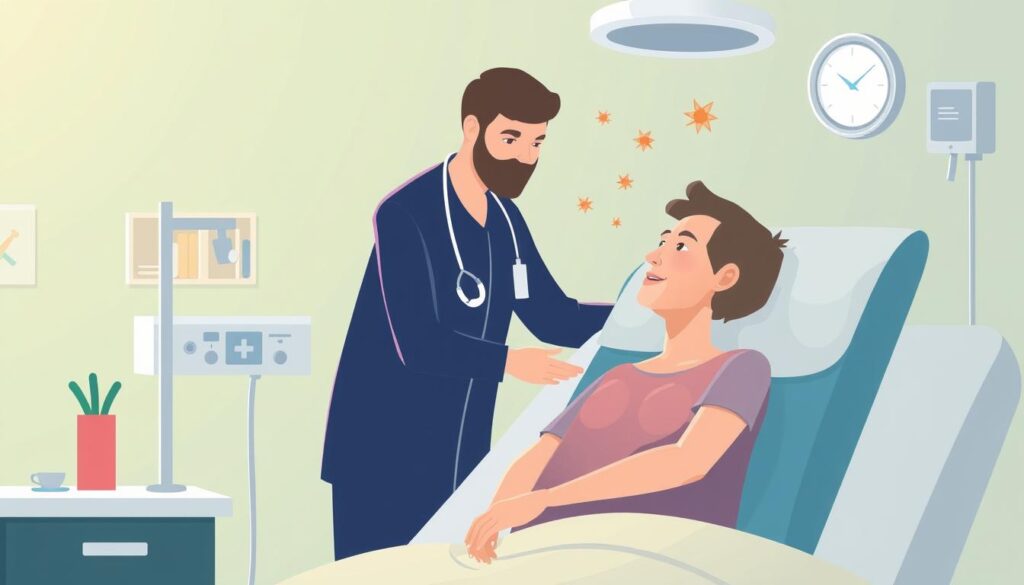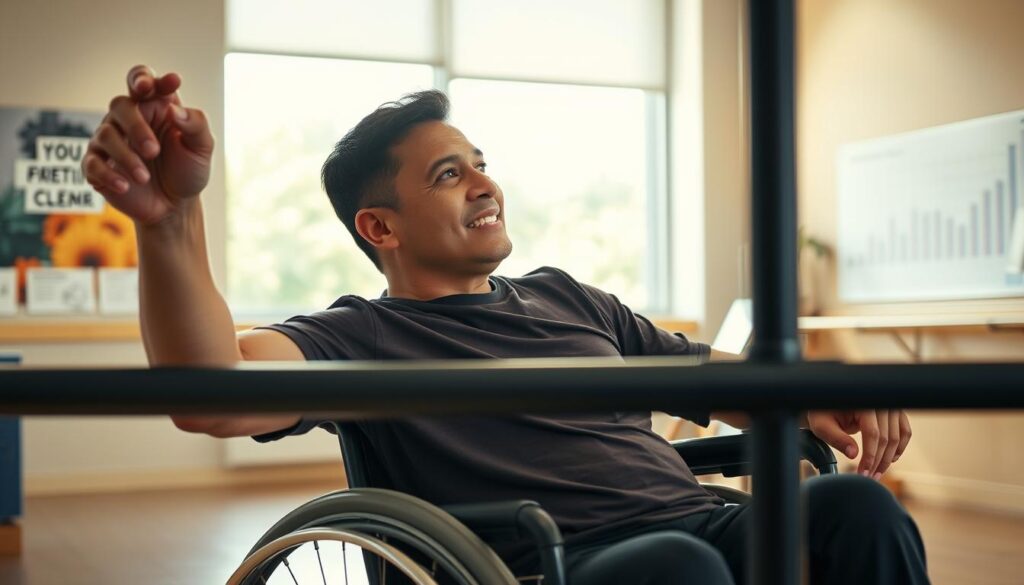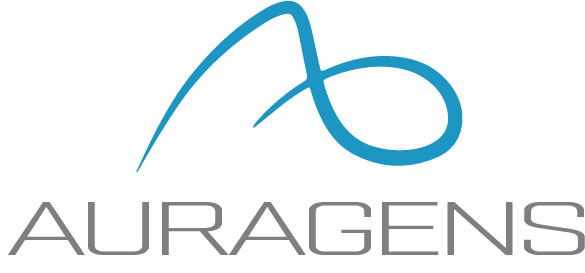Effective Stroke Recovery: Stem Cells Help Regain Independence & Health
As Dr. Jill Bolte Taylor, stroke recovery patients and a neuroanatomist who experienced a stroke, once said, “The moment-to-moment awareness of our experience is the essence of who we are.” This powerful quote resonates deeply with my own journey of recovering from a stroke.
I’ve come to realize that understanding the impact of stroke on the brain and body is crucial for effective recovery. In this article, I’ll share my personal experience and explore both traditional and innovative treatments, including stem cell therapy, that can help regain independence and improve overall health.
Recognizing the signs and symptoms of a stroke is vital for prompt medical attention, and I’ll discuss the critical timeline for recovery and the importance of early intervention.
Key Takeaways
- Understanding the impact of stroke on the brain and body is crucial for effective recovery.
- Stem cell therapy offers new hope for stroke survivors who may have plateaued in their recovery.
- Early intervention is critical for maximizing healing potential.
- Recognizing the signs and symptoms of a stroke is vital for prompt medical attention.
- A comprehensive guide to traditional and innovative stroke treatments can empower survivors with knowledge.
Understanding Stroke and Its Impact
Understanding the impact of a stroke is crucial for effective recovery. A stroke can have far-reaching consequences on an individual’s physical and cognitive abilities.
What Happens During a Stroke
During a stroke, the brain’s blood supply is interrupted or reduced, depriving it of oxygen and nutrients. This can cause damage to brain cells, leading to various symptoms such as weakness on one side of the body, speech difficulties, and memory loss. As I learned, a hemorrhagic stroke occurs when an artery in the brain leaks blood or ruptures, putting too much pressure on brain cells and damaging them.
Types of Strokes and Their Effects
There are different types of strokes, including ischemic, hemorrhagic, and transient ischemic attacks (TIAs or “mini-strokes”). Each type has unique effects and requires different medical interventions. For instance, ischemic strokes occur when a blood clot blocks an artery, while hemorrhagic strokes involve bleeding in the brain. Understanding the type of stroke is crucial for proper treatment and recovery. To learn more about innovative treatments for stroke recovery, visit Auragen’s stem cell therapy page.
My Personal Stroke Journey
My stroke journey began unexpectedly, changing my life forever. The experience was sudden and left me facing numerous challenges that I had never anticipated.
The Day Everything Changed
The day of my stroke was like any other until it wasn’t. I suddenly felt weakness on one side of my body and had trouble with speech. It was as if my body had betrayed me, and I was left struggling to understand what was happening. The immediate aftermath was overwhelming, with fear and uncertainty gripping me as I was rushed to the hospital.
Initial Challenges I Faced
The initial challenges were multifaceted. I faced physical hurdles such as mobility issues and coordination problems. Cognitively, I struggled with memory and concentration. Emotionally, I battled depression and frustration. Simple tasks became daunting, and I had to relearn many basic activities. Here are some of the key difficulties I encountered:
- Physical weakness and coordination issues
- Cognitive difficulties, including memory and concentration problems
- Emotional struggles, such as depression and frustration
- Communication challenges due to speech difficulties
Despite these challenges, I began my stroke recovery journey from the moment I was stabilized. Healthcare professionals assessed the effects of my stroke and started me on the path to rehabilitation. It was a long and arduous journey, but understanding the road ahead helped me face it with determination.
Traditional Stroke Recovery Methods
The journey to recovery after a stroke typically involves a combination of established medical treatments and therapies. These traditional methods have been widely used to help stroke survivors regain their independence and improve their quality of life.
Standard Medical Treatments
Standard medical treatments for stroke recovery often focus on addressing the underlying causes of the stroke and managing related health conditions. Medications may be prescribed to prevent further strokes, manage blood pressure, and control other risk factors. Effective management of these conditions is crucial for a successful recovery.
Physical and Occupational Therapy
Physical and occupational therapy play a vital role in helping stroke survivors regain physical strength, mobility, and independence. Physical therapists work on improving balance, coordination, and overall physical function, while occupational therapists help patients relearn daily living skills and adapt to any lasting changes. Therapy is tailored to the individual’s needs and goals.
Speech Therapy and Cognitive Rehabilitation
Speech therapy is essential for individuals who experience communication difficulties after a stroke, such as aphasia or dysarthria. Speech therapists use various techniques to help rebuild language skills and improve communication abilities. Cognitive rehabilitation addresses thinking skills like memory, attention, and problem-solving, helping patients compensate for ongoing challenges.
These traditional stroke recovery methods are often used in conjunction with one another to provide comprehensive care. By combining medical treatments, physical therapy, occupational therapy, speech therapy, and cognitive rehabilitation, stroke survivors can achieve significant improvements in their overall health and independence.
The Stroke Recovery Timeline
The path to regaining health and independence after a stroke is influenced by multiple factors, including the severity of the stroke, the timeliness and quality of initial care, and the intensity of rehabilitation efforts.
First Three Months: Critical Recovery Period
The first three months following a stroke are often considered the most critical period for recovery. During this time, the brain undergoes significant changes as it attempts to compensate for damaged areas. Rapid improvements are commonly observed in many patients, with some regaining substantial function. The intensity of rehabilitation during this period plays a crucial role in determining the extent of recovery.

Six Months and Beyond: Long-Term Healing
After six months, while the rate of improvement may slow, continued progress is still possible for many stroke survivors. The focus of rehabilitation often shifts towards teaching compensation strategies and adapting to any lasting impairments. It’s during this phase that motivation and persistence become vital, as patients work to achieve the best possible outcome. Some individuals continue to experience significant improvements even years after their stroke, challenging traditional notions of a recovery plateau.
Introduction to Stem Cell Therapy for Stroke Recovery

As the medical community continues to explore innovative solutions for stroke recovery, stem cell therapy stands out as a particularly promising avenue. This treatment involves using stem cells, which have the unique ability to develop into various cell types, to promote healing in the brain.
Stem cell therapy is being investigated for its potential to improve outcomes for stroke patients by enhancing brain repair and regeneration. The therapy aims to address the complex challenges posed by stroke, including cognitive, motor, and emotional impairments.
How Stem Cells Work in Brain Healing
Stem cells contribute to brain healing by differentiating into cells that replace or repair damaged brain tissue. They also release growth factors that promote angiogenesis (the formation of new blood vessels) and neurogenesis (the growth of new neurons), which are critical for recovery.
Key mechanisms include reducing inflammation, promoting neural plasticity, and supporting the survival of existing neurons. By enhancing these natural healing processes, stem cell therapy may help improve functional outcomes for stroke survivors.
Current Research and Treatment Options
Current research on stem cell therapy for stroke is focused on evaluating its safety and efficacy through clinical trials. Various types of stem cells are being studied, including mesenchymal stem cells and induced pluripotent stem cells, each with different approaches to promoting brain healing.
Some of the key aspects being investigated include the optimal dosage, timing, and method of stem cell administration. Treatment options range from intravenous and intracerebral to intrathecal delivery, each with its potential benefits and risks.
As research progresses, we can expect to gain a better understanding of how stem cell therapy can be integrated into comprehensive stroke recovery plans, potentially offering new hope for improved outcomes.
My Experience with Stem Cell Treatment
Undergoing stem cell therapy was a pivotal decision in my stroke recovery journey. It marked a significant shift in my approach to regaining my health and independence.
Making the Decision
The decision to undergo stem cell treatment was not taken lightly. After consulting with my medical team and researching the potential benefits and risks, I decided that it was worth trying. I was particularly drawn to the possibility of improvements in my condition that traditional rehabilitation hadn’t achieved.
The Treatment Process
The stem cell treatment process was relatively straightforward. I received injections of stem cells, and my medical team closely monitored my recovery and response to the treatment. The entire process was designed to maximize the potential effects of the therapy.
Initial Results and Progress
In the weeks following the treatment, I began to notice positive changes. My progress was tracked through regular assessments, and I was pleased to see improvements in my mobility and cognitive function over time. A summary of my progress is shown in the table below:
| Assessment Criteria | Pre-Treatment | Post-Treatment (6 weeks) |
|---|---|---|
| Mobility Score | 40% | 60% |
| Cognitive Function | 50% | 70% |
| Speech Ability | 30% | 55% |
The results were encouraging, and my experience with stem cell therapy for stroke recovery has been positive. While there’s still a long way to go, I’m hopeful about the potential for continued stroke recovery.
Regaining Independence Through Stem Cell Therapy
Stem cell therapy has been a game-changer for my stroke recovery, enabling me to regain my independence. After undergoing this treatment, I noticed significant improvements in various aspects of my health.
Physical Improvements I Experienced
I observed notable physical improvements following stem cell therapy. My brain began to heal, and I regained some of the motor functions that were affected by the stroke. According to a study published on Gladstone.org, stem cell therapy can indeed jumpstart brain recovery after a stroke.
| Physical Ability | Pre-Therapy | Post-Therapy |
|---|---|---|
| Walking | Difficult with assistance | Independent with some balance issues |
| Hand Movement | Limited mobility | Improved dexterity |
| Balance | Poor | Better, but still challenging |

Cognitive and Emotional Recovery
In addition to physical improvements, I also experienced cognitive and emotional enhancements. My memory showed signs of improvement, and I was less troubled by depression. The therapy had a positive impact on my overall recovery, reducing the effects of the stroke and improving my mental health. I was able to manage my emotions better and had fewer instances of emotional turmoil.
As I continued on my recovery journey, I found that stem cell therapy, combined with other rehabilitation strategies, significantly enhanced my quality of life. For more information on stem cell therapy applications, you can visit Auragens.com.
Comprehensive Stroke Recovery Strategies
A comprehensive stroke recovery plan is essential for regaining health and independence. As a stroke survivor, I’ve learned that combining different approaches can significantly enhance the recovery process.
Combining Stem Cell Therapy with Traditional Rehabilitation
I’ve found that integrating stem cell therapy with traditional rehabilitation methods can be highly effective. This combined approach allowed me to capitalize on the benefits of both medical treatments and physical therapy, leading to improved overall recovery.
- Enhanced physical improvements through coordinated therapy sessions
- Better cognitive function due to comprehensive rehabilitation
- Increased potential for regaining independence
Lifestyle Changes That Enhanced My Recovery
Making significant changes to my lifestyle played a crucial role in my stroke recovery. By addressing risk factors such as high blood pressure and adopting healthier habits, I was able to reduce my risk of experiencing another stroke.
- Adopting a Mediterranean diet to support brain health
- Developing an exercise regimen to improve cardiovascular well-being
- Managing stress through meditation and mindfulness practices
- Improving sleep quality to aid in overall recovery
By incorporating these comprehensive strategies, I was able to enhance my recovery and reduce the risk of future strokes. It’s essential for stroke survivors to work closely with their healthcare providers to develop a personalized recovery plan.
Conclusion: Hope for Stroke Survivors
The road to recovery after a stroke is long and challenging, but with the right support and treatment, it’s possible to regain independence and improve quality of life. My journey has shown me that hope and persistence are crucial, even when progress seems slow.
I’ve learned that comprehensive care, including traditional rehabilitation and innovative treatments like stem cell therapy, can significantly impact recovery. Research on stem cell therapy for stroke recovery is ongoing, with promising results, as seen in studies available on PubMed Central.
For people at high risk of another stroke, managing conditions like heart disease and high blood pressure is vital. Support from loved ones and access to various services also play a critical role in the recovery process.
While the journey is unique to each individual, the importance of a supportive community and advanced medical treatments cannot be overstated. By sharing my story, I hope to inspire hope in others and highlight the potential for a fulfilling life after a stroke.
FAQ
What are the common effects of a stroke on the brain?
A stroke can cause damage to the brain, leading to various effects such as weakness on one side of the body, trouble with speech, and memory loss. The extent of the damage depends on the type and severity of the stroke.
How does high blood pressure relate to the risk of having a stroke?
High blood pressure is a significant risk factor for stroke, as it can cause blood vessels in the brain to burst or become blocked, leading to an ischemic or hemorrhagic stroke.
What is the role of physical therapy in stroke rehabilitation?
Physical therapy plays a crucial role in helping individuals regain physical strength and mobility after a stroke. It involves exercises and activities tailored to improve balance, coordination, and overall physical function.
Can depression be a complication after a stroke, and how is it managed?
Yes, depression is a common complication after a stroke. It can be managed through a combination of medication, counseling, and lifestyle changes, which can help improve overall mental health and well-being.
How can lifestyle changes support stroke prevention and treatment?
Making healthy lifestyle changes, such as maintaining a balanced diet, exercising regularly, and managing stress, can help reduce the risk of another stroke and support overall health.
What is the significance of the first three months after a stroke?
The first three months after a stroke are considered a critical period for recovery, as the brain is most responsive to rehabilitation efforts during this time. Intensive therapy and treatment can lead to significant improvements.
Can stem cell therapy be used in conjunction with traditional stroke rehabilitation methods?
Yes, stem cell therapy can be used in combination with traditional rehabilitation methods, such as physical, occupational, and speech therapy, to enhance the recovery process and promote overall healing.
